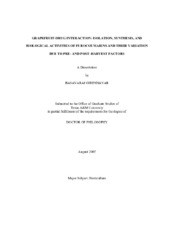| dc.contributor.advisor | Patil, Bhimanagouda | |
| dc.creator | Girennavar, Basavaraj | |
| dc.date.accessioned | 2010-01-15T00:02:01Z | |
| dc.date.accessioned | 2010-01-16T01:53:42Z | |
| dc.date.available | 2010-01-15T00:02:01Z | |
| dc.date.available | 2010-01-16T01:53:42Z | |
| dc.date.created | 2007-08 | |
| dc.date.issued | 2009-05-15 | |
| dc.identifier.uri | https://hdl.handle.net/1969.1/ETD-TAMU-1537 | |
| dc.description.abstract | The health maintaining properties of citrus consumption are attributed to the wide
assortment of bioactive compounds. Consumption of grapefruit along with certain
medications, however, is posing a risk of drug toxicity and side reactions. The first study
involved isolation of bioactive furocoumarins with a combination of chromatographic
techniques and synthesis. Five furocoumarins namely, dihydroxybergamottin, paradisin
A, bergamottin, bergaptol and geranylcoumarin were isolated from grapefruit and series
of furocoumarin monomers and paradisin A were synthesized. The second study involved
influence of pre- and post-harvest factors on the levels of furocoumarins in grapefruit
juice. Considerable differences were observed in the levels of these compounds in
different grapefruit cultivars. Ray Red showed the lowest levels of all three
furocoumarins and Duncan contains the highest amount of DHB and bergamottin, where
as the highest levels of paradisin A was observed in Star Ruby. The highest levels of
DHB and bergamottin were found in Flame cultivar grown in California. The changes in
the levels of these furocoumarins during the season in Rio Red and Marsh White
grapefruit cultivars were evaluated. The third study investigated biological activities of grapefruit juices and
furocoumarins. Grapefruit and Pummelo juices were found to be potent inhibitors of
cytochrome CYP3A4 and CYP2C9 isoenzymes at 5% concentration while CYP2D6 was
less affected. Among the five furocoumarins tested, the inhibitory potency was in the
order of paradisin A>dihydroxybergamottin>bergamottin>bergaptol>geranylcoumarin at
0.1 µM to 0.1 mM concentrations. A fourth study investigated the effect of
furocoumarins on bacterial auto-inducer signaling, and found that furocoumarins are
potent inhibitors of AI-1 and AI-2 activities at 0.01% concentration. In a fifth study,
involving synthesized furocoumarin monomers and dimer on anti-proliferative activities
on normal and cancer cell lines, furocoumarins found to be non-toxic to normal cells.
However, bergamottin showed a significant anti-proliferative activity in HT-29 and
MCF-7 cell lines.
This dissertation indicates that furocoumarins are bioactive compounds from
grapefruit juice with potent inhibitory property of major drug metabolizing cytochrome
P450 isoenzymes. Furocoumarins show a considerable variation between varieties,
location and season. These results corroborate the involvement of furocoumarins in
grapefruit drug interaction. | en |
| dc.format.medium | electronic | en |
| dc.format.mimetype | application/pdf | |
| dc.language.iso | en_US | |
| dc.subject | Grapefruit | en |
| dc.subject | Bioactive compounds | en |
| dc.subject | Drug-interaction | en |
| dc.subject | cytochrome P450 enzyme | en |
| dc.subject | Furocoumarins | en |
| dc.subject | Pre- and post-harvest factors | en |
| dc.title | Grapefruit-drug interaction: isolation, synthesis, and biological activities of furocoumarins and their variation due to pre- and post-harvest factors. | en |
| dc.type | Book | en |
| dc.type | Thesis | en |
| thesis.degree.department | Horticultural Sciences | en |
| thesis.degree.discipline | Horticulture | en |
| thesis.degree.grantor | Texas A&M University | en |
| thesis.degree.name | Doctor of Philosophy | en |
| thesis.degree.level | Doctoral | en |
| dc.contributor.committeeMember | Jayaprakasha, G. K. | |
| dc.contributor.committeeMember | Jifon, John | |
| dc.contributor.committeeMember | Lombardini, Leonardo | |
| dc.contributor.committeeMember | Murano, Peter | |
| dc.contributor.committeeMember | Pike, Leonard | |
| dc.type.genre | Electronic Dissertation | en |
| dc.type.material | text | en |
| dc.format.digitalOrigin | born digital | en |


